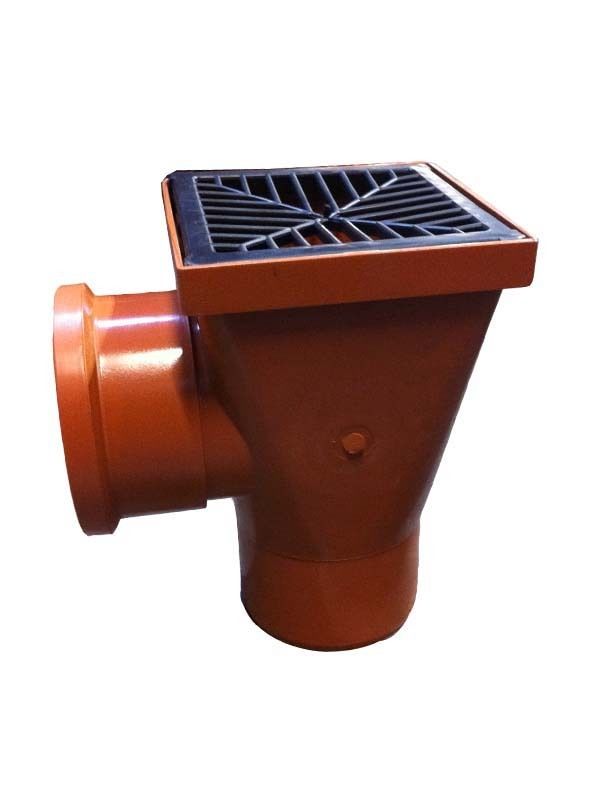Gulley

|
A gulley is a fitting with a chamber which is designed to collect rainwater, wastewater and groundwater, conveying it to an underground surface-water sewer. Gullies can be used to drain waste water and rainfall from buildings, large paved areas and roadsides, pedestrian areas, parking areas, pavements, roofs and so on.
Usually buried in the ground, the gulley’s configuration typically involves a chamber and a trap (sometimes referred to as a trapped gulley), while its top surface often has a grille over which a waste or rainwater pipe can discharge. Trapped gullies can also be used to take waste water from household sinks and baths. Thus, gullies can collect rainwater from roofs, impervious surfaces and waste water from buildings. When used to drain large areas, they are frequently called yard gullies or road gullies.
The gulley’s top grille is usually designed to prevent leaves, litter and large objects from blocking the system, while the trap – which can be a P-, Q- or S-type – prevents odours from escaping into the environment and can make it difficult for rats to reach the surface. Over time, the level of sediment collecting in a trap can cause blockages which may require manual removal or mechanical suction.
Traditionally, gullies were made from cast iron or vitrified clay, but these have been largely superseded by PVC which is both cheaper and lighter whilst still being durable.
When a trapped gulley features a below-ground inlet coming from another gulley or water source, it is termed a back-inlet gulley. The horizontal inlet is typically located below the top grille but above the level of the water seal. Many gulley types provide the facility to rod the system when a blockage occurs down the line.
A gulley can also be a grated opening in a road gutter; or in a hard-landscaped area to evacuate rainwater from the surface.
Gulleys can also be used internally, e.g buried in the floor in a wet room application.
[edit] Related articles on Designing Buildings Wiki
- Approved Document H.
- Difference between drains and sewers.
- Drainage stack.
- Drains.
- Grease management.
- Groundwater control in urban areas.
- Gully.
- Highway drainage.
- Invert
- Pipelines.
- Pipework.
- Public sewer.
- Rain gutter.
- Rainwater downpipe.
- Safe working in drains and sewers.
- Sewer construction.
- Sewerage.
- Soakaway.
- Soil vent pipe.
- Waste water.
- Water transfers and interconnections.
Featured articles and news
Latest Build UK Building Safety Regime explainer published
Key elements in one short, now updated document.
UKGBC launch the UK Climate Resilience Roadmap
First guidance of its kind on direct climate impacts for the built environment and how it can adapt.
CLC Health, Safety and Wellbeing Strategy 2025
Launched by the Minister for Industry to look at fatalities on site, improving mental health and other issues.
One of the most impressive Victorian architects. Book review.
Common Assessment Standard now with building safety
New CAS update now includes mandatory building safety questions.
RTPI leader to become new CIOB Chief Executive Officer
Dr Victoria Hills MRTPI, FICE to take over after Caroline Gumble’s departure.
Social and affordable housing, a long term plan for delivery
The “Delivering a Decade of Renewal for Social and Affordable Housing” strategy sets out future path.
A change to adoptive architecture
Effects of global weather warming on architectural detailing, material choice and human interaction.
The proposed publicly owned and backed subsidiary of Homes England, to facilitate new homes.
How big is the problem and what can we do to mitigate the effects?
Overheating guidance and tools for building designers
A number of cool guides to help with the heat.
The UK's Modern Industrial Strategy: A 10 year plan
Previous consultation criticism, current key elements and general support with some persisting reservations.
Building Safety Regulator reforms
New roles, new staff and a new fast track service pave the way for a single construction regulator.
Architectural Technologist CPDs and Communications
CIAT CPD… and how you can do it!
Cooling centres and cool spaces
Managing extreme heat in cities by directing the public to places for heat stress relief and water sources.
Winter gardens: A brief history and warm variations
Extending the season with glass in different forms and terms.
Restoring Great Yarmouth's Winter Gardens
Transforming one of the least sustainable constructions imaginable.






















